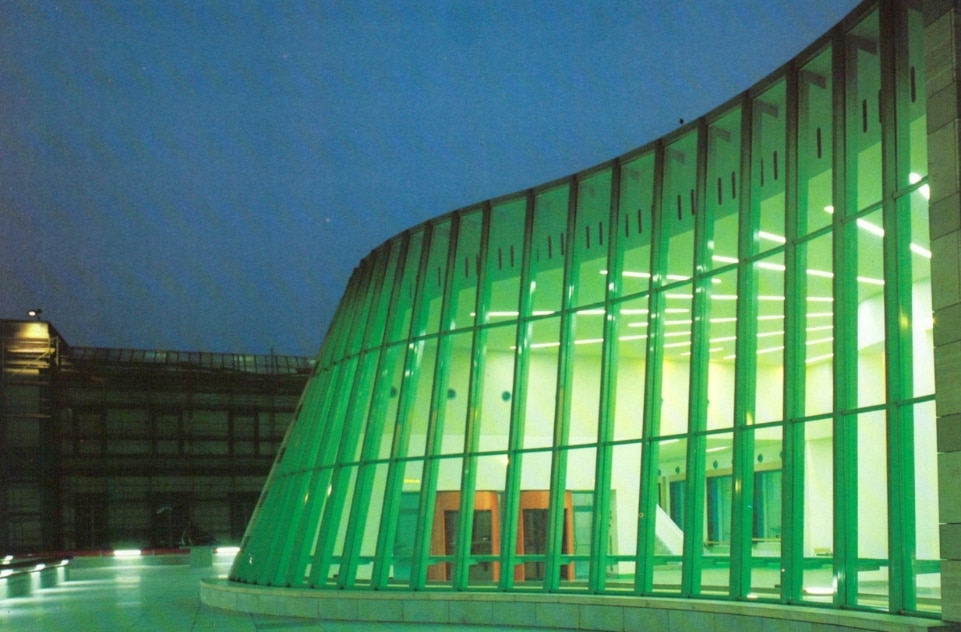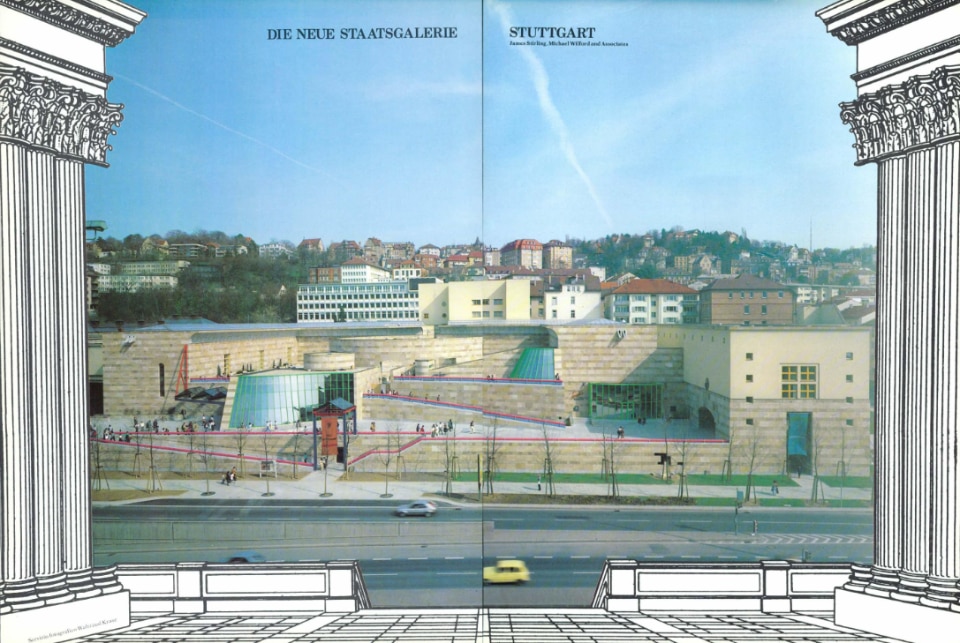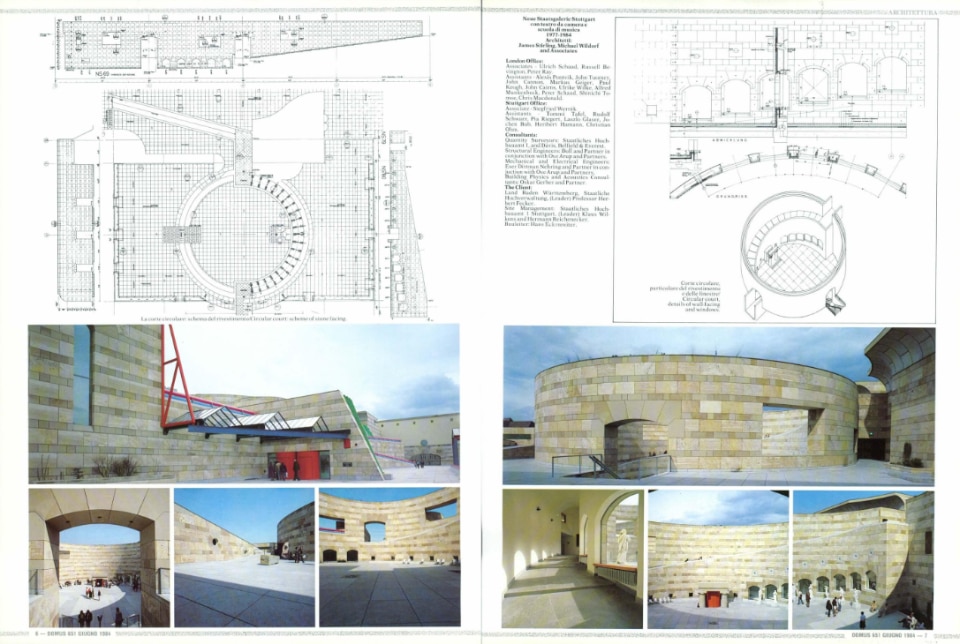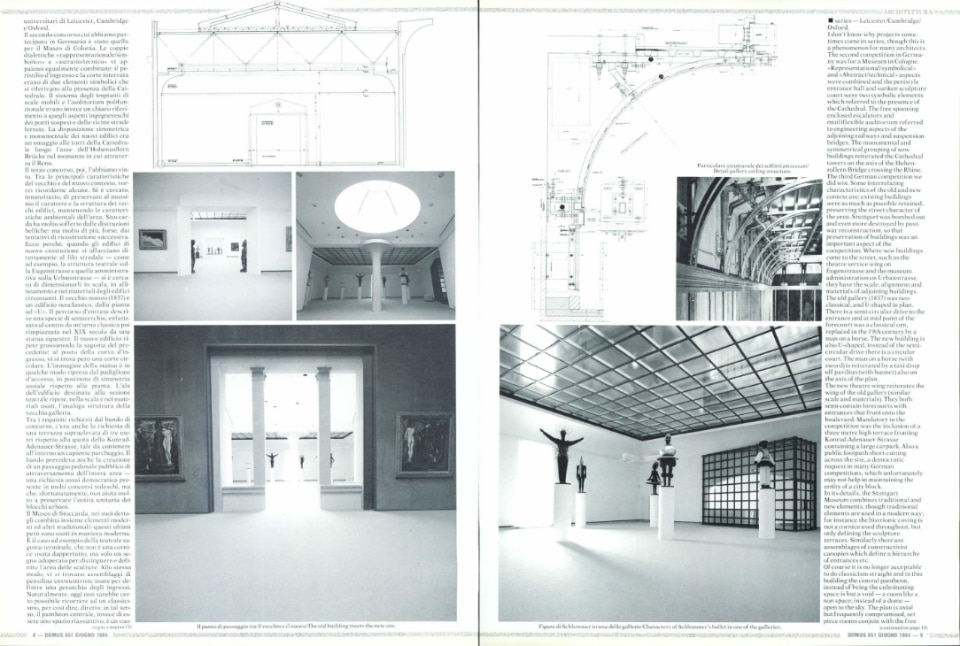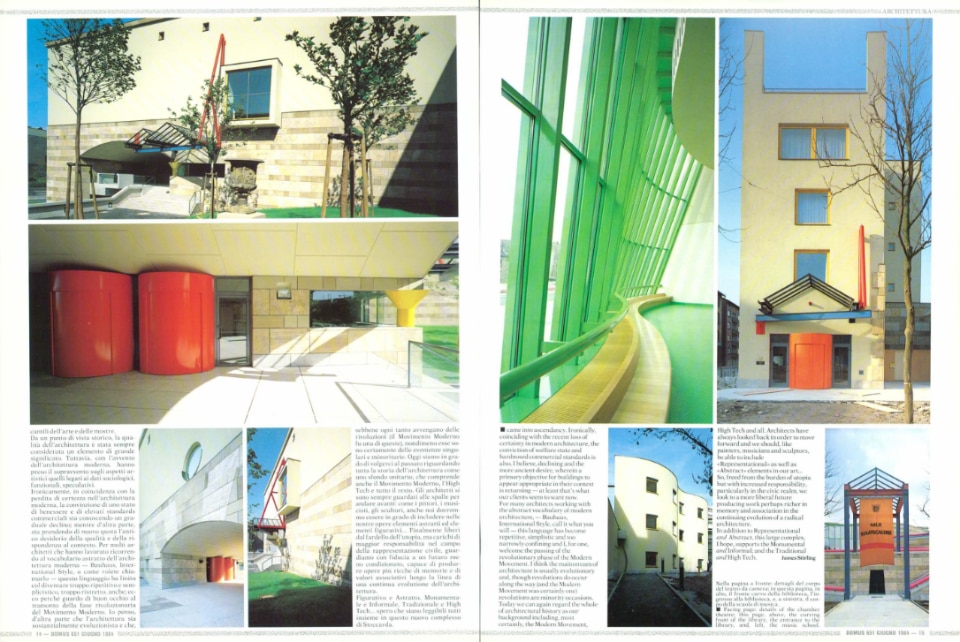There are few figures who could cross chapters and chapters of history, managing to write words in all of them that could become iconic: James Stirling in architecture is one of those, from his early moves within the British modern, to his critical relationship with radicalism, utopias and various technological dreams, to the most blunt postmodernism practiced through the 90s.
His postmodernism, however, could since the beginning be noticed for an unprecedented level of sophistication, intimately British in the way it used irony and eschewed the “boxing” inside any theoretical category. The Neue Staatsgalerie in Stuttgart, built at the turn of the 1970s and 1980s, is made of an irony exercised on a classicism that is carefully studied but ceaselessly discussed: symmetries are broken, elements of the modern, the pop-radical, and even the high-tech enter the project in gambits. It is an architecture whose shapes comment as much on classical heritage as on the city, its history and its evolution, and this is how Stirling himself introduced this work to Domus readers, in June 1984, on issue 651, where also an exchange between him and then director Alessandro Mendini was featured.
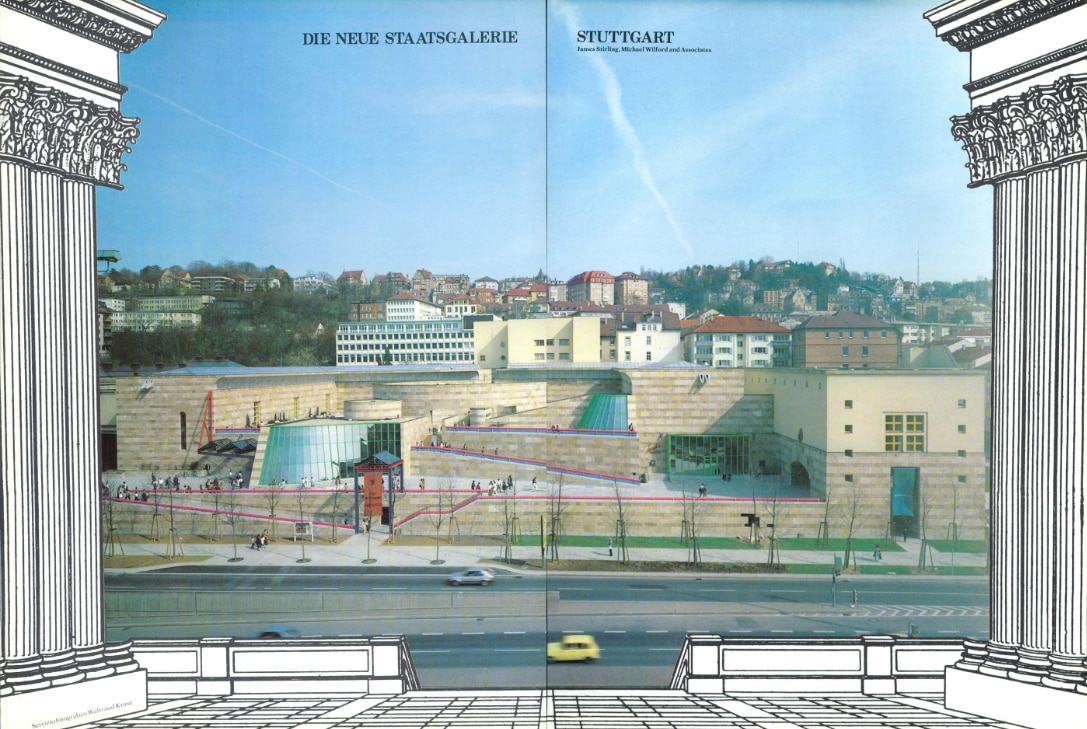
Die Neue Staatsgalerie Stuttgart
In 1975 we were invited to take part in two limited competitions in West Germany, the first fora Museum in Düsseldorf: in this design a neo-classical type Düsseldorf entrance pavilion is, as it were, pulled out from a circular void to symbolise and represent the whole museum, which to minimise its impact on the historic centre, was otherwise buried in the city block. “Neo-classical” as there were several such buildings nearby and because I think there is an identifying association still attaching to 19th century museums.
The main building may be “Abstract” but the entrance pavilion is more “Representational” related to tradition, history and familiarity, and maybe with archaeology and memory, as prior to the war a building of about the same size had stood in this place exhibiting the city's art treasures. I particularly regret we didn't built this project. It was the first in our German museum series – Düsseldorf/Cologne/ Stuttgart.
Similar to our earlier Universityseries — Leicester/Cambridge/ Oxford. I don't know why projects sometimes come in series, though this is a phenomenon for many architects. The second competition in Germany was for a Museum in Cologne. “Representational/symbolical” and “Abstract/technical” aspects were combined and the peristyle entrance hall and sunken sculpture court were two symbolic elements which referred to the presence of the Cathedral.
The free spanning enclosed escalators and mutliflexible auditorium referred to engineering aspects of the adjoining railways and suspension bridges. The monumental and symmetrical grouping of new buildings reiterated the Cathedral towers on the axis of the Hohenzollern Bridge crossing the Rhine.
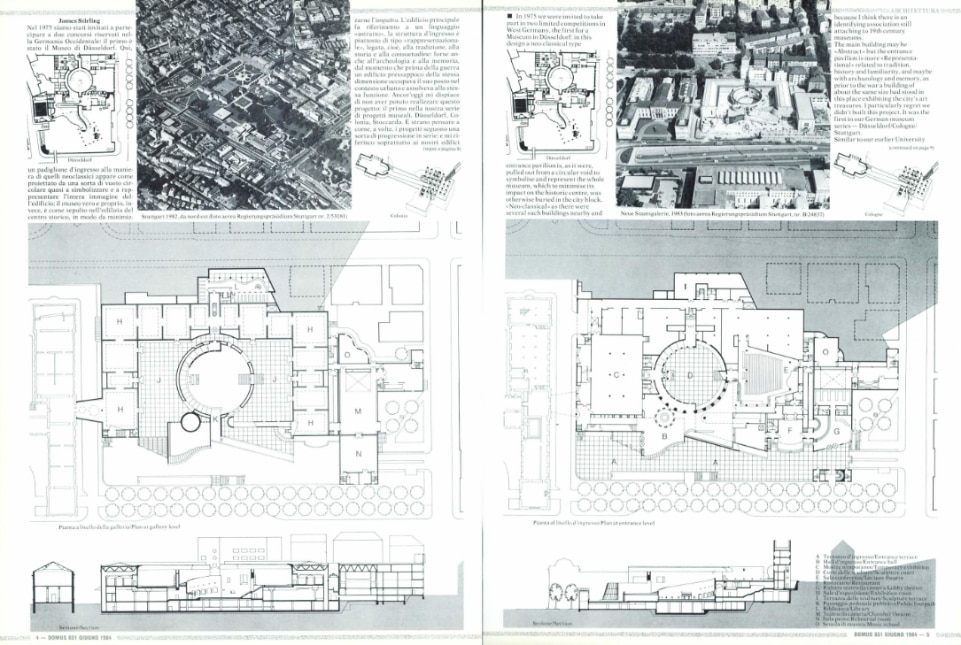
The third German competition we did win. Some interrelating characteristics of the old and new context are: existing buildings were as much as possible retained, preserving the street character of the area. Stuttgart was bombed out and even more destroyed by postwar reconstruction, so that preservation of buildings was an important aspect of the competition.
Where new buildings come to the street, such as the theatre service wing on Eugenstrasse and the museum administration on Urbanstrasse, they have the scale, alignment and materials of adjoining buildings. The old gallery (1837) was neoclassical, and U-shaped in plan. There is a semi-circular drive to the entrance and at mid point of the forecourt was a classical urn, replaced in the 19th century by a man on a horse. The new building is also U-shaped, instead of the semicircular drive there is a circular court. The man on a horse (with sword) is reiterated by a taxi drop off pavilion (with banner) also on the axis of the plan. The new theatre wing reiterates the wing of the old gallery (similar scale and materials). They both semi-contain forecourts with entrances that front onto the boulevard.
Mandatory to the competition was the inclusion of a three metre high terrace fronting Konrad-Adenauer-Strasse containing a large carpark. Also a public footpath short-cutting across the site, a democratic request in many German competitions, which unfortunately may not help in maintaining the entity of a city block.
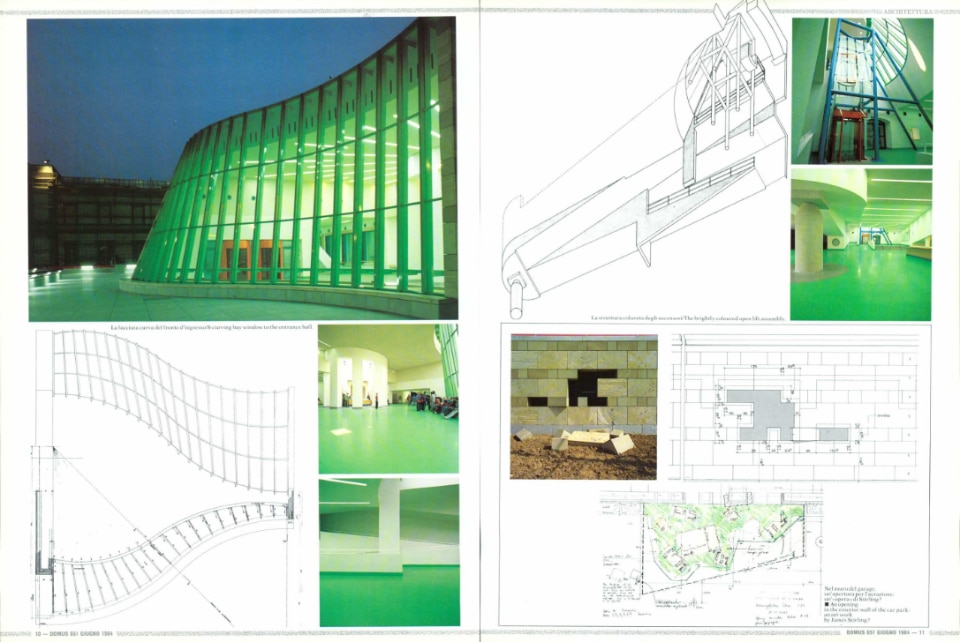
In its details, the Stuttgart Museum combines traditional and new elements, though traditional elements are used in a modern way; for instance the histrionic coving is not a cornice used throughout, but only defining the sculpture terraces. Similarly there are assemblages of constructivist canopies which define a hierarchy of entrances etc.
Of course it is no longer acceptable to do classicism straight and in this building the central pantheon, instead of being the culminating space is but a void – a room like a non space; instead of a dome – open to the sky. The plan is axial but frequently compromised, set piece rooms conjoin with the freeplan and the public footpath meanders either side of the central axis, – thus the casually monumental is diminished by the deliberately informal. The ambivalence of the “front” corresponds to the ambiguity of the boulevard (Konrad-Adenauer-Strasse is more an Autobahn than a street). Instead of a “façade” the front recedes, presenting a series of incidents adjacent to the walking movement, into, through and across the building.
Some details which contribute to the “monumentally informal” are: the juxtaposition of stone walls and highly coloured metal assemblies – such as the entrance canopies and tat tube parapet handrails and the S-curving bay window to the entrance hall, also the taxi drop off pavilion, air intake funnels, etc. These colorful elements counteract the possible appearance of a monumental stone quarry. Internally the green rubber flooring reminds that museums today are also places of popular entertainment – it seemed more appropriate as well as having an acoustic value. The brightly colored open lift assembly, and sunburst ceiling lighting and the curved counter tops etc. all contribute to the informal.
The ceiling light grid of the Kunsthalle may remind us that like shopping malls there is today a market side to art and exhibition. Historically, the quality of the art in the architecture is remembered as the significant element. However, with the advent of modern architecture, sociological, functional and real estate valuescame into ascendancy.
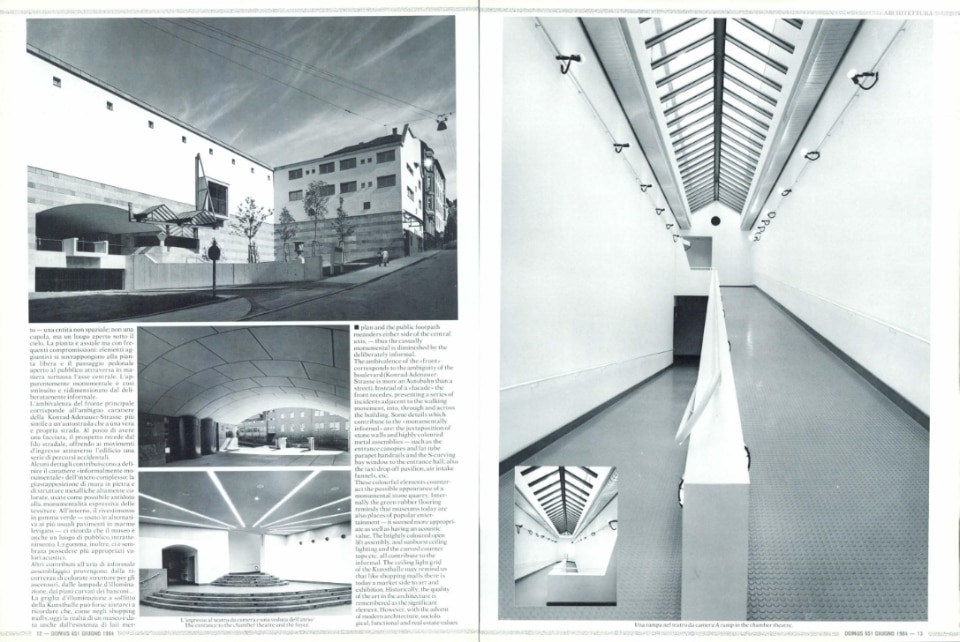
Ironically, coinciding with the recent loss of certainty in modern architecture, the conviction of welfare state and hardnosed commercial standards is also, I believe, declining and the more ancient desire, wherein a primary objective for buildings to appear appropriate in their context is returning – at least that's what our clients seem to want now. For many architects working with the abstract vocabulary of modern architecture, – Bauhaus, International Style, call it what you will – this language has become repetitive, simplistic and too narrowly confining and I, for one, welcome the passing of the revolutionary phase of the Modern Movement. I think the mainstream of architecture is usually evolutionary and, though revolutions do occur along the way (and the Modern Movement was certainly one) revolutions are minority occasions. Today we can again regard the whole of architectural history as our background including, most certainly, the Modern Movement, High Tech and all.
Architects have always looked back in order to move forward and we should, like painters, musicians and sculptors, be able to include “Representational” as well as “Abstract” elements in our art… So, freed from the burden of utopia but with increased responsibility, particularly in the civic realm, we look to a more liberal future producing work perhaps richer in memory and association in the continuing evolution of a radical architecture.
In addition to Representational and Abstract, this large complex, I hope, supports the Monumental and Informal; and the Traditional and High Tech.
- London Office:
- Associates - Ulrich Schaad, Russell Bevington, Peter Ray. Assistants - Alexis Pontvik, John Tuomey, John Cannon, Markus Geiger, Paul Keogh, John Cairns, Ulrike Wilke, Alfred Munkenbeck, Peter Schaad, Shinichi Tomoe, Chris Macdonald.
- Stuttgart Office:
- Associate - Siegfried Wernik. Assistants - Tortimi Tafel, Rudolf Schwarz, Pia Riegert, Laszlo Glaser, Jochen Bub, Heribert Hamann, Christian Ohm.
- Consultants:
- Quantity Surveyors: Staatliches Hochbauamt 1, and Davis, Belfield & Everest. Structural Engineers: Boll and Partner in conjunction with Ove Arup and Partners. Mechanical and Electrical Engineers: Eser Dittman Nehring and Partner in conjuction with Ove Arup and Partners. Building Physics and Acoustics Consultants: Oskar Gerber and Partner.
- The Client:
- Land Baden Württemberg, Staatliche Hochverwaltung, (Leader) Professor Herbert Fecker. Site Management: Staatliches Hochbauamt 1 Stuttgart, (Leader) Klaus Wilkens and Hermann Reichenecker. Bauleiter: Hans Eckenreiter.


